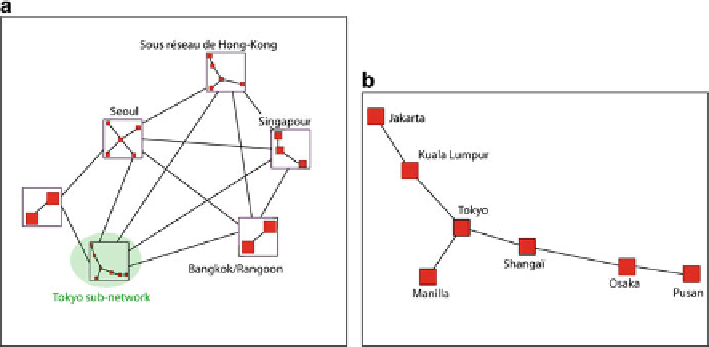Information Technology Reference
In-Depth Information
Fig. 9.8
Clustering of Worldwide air traffic: focus on Asian cluster
not well-integrated into the system, with the hubs displaying a burst structure in the
form of various subgroups, the Asian system is very connected and forms a group
with whole market share (Fig.
9.8
).
The Asian system can be broken down at a second level (Fig.
9.8
a). In particular,
this system is organized around two poles, Hong Kong and Tokyo. Decomposition at
a third level, around the Tokyo pole, shows an international system that is strongly
integrated around the Japanese capital: the system spans Jakarta to Pusan while
passing through Shanghai (Fig.
9.8
b). The insularity of the Asian area partly justifies
the strong integration of the regional network. Moreover, the potential and the
demand for air transport in Asia involve increasingly strong competition between
airports and cities (
Park
,
2003
).
At the other end of the spectrum, the European system appears to be less well-
integrated from Stockholm to Lisbon, undoubtedly because of the complex history
of the airspace burst structure. Indeed, national companies, under pressure from
the states, organized hubs for each large European capital. It was only with the
deregulation of the European skies in 1993 that the management experience of the
European air routes was transferred to private airlines (
Burghouwt, Hakfoort, &
Ritsema van Eck
,
2003
). Despite the efforts of the European Community to build
a coherent airspace, great competition still exists between the principal European
hubs, such as London, Paris, Frankfurt and Amsterdam (
Graham
,
1998
).
Some cities, although strongly dependent on the major hubs or the two non-
intermitting systems, have few connections between hubs. This is the case for cities
in Latin America such as Bogota, Buenos Aires, and Santiago and for cities in the
Middle East such as Dubai, Tehran, Jeddah, and Riyadh. There is intense traffic
between the large South American capitals and the central network because the
majority of the exchanges are with the international network, starting exclusively
from the large capitals. These capitals have reproduced the traffic resulting from
the neo-liberal policies of airspace openings, producing a star distribution network
around the hub and spokes system (
Lipovich
,
2002
).

Search WWH ::

Custom Search